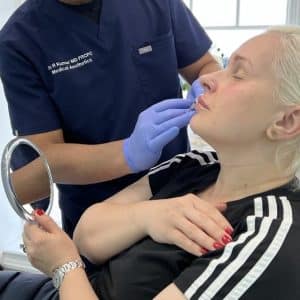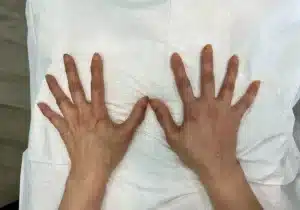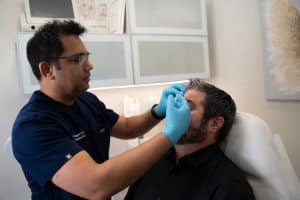What’s more important to a woman as she ages: looking younger or more attractive?
Talking to our female patients (who are about 90% of our patients), we found that women want to look more beautiful rather than younger — it’s typically men who focus on recapturing a youthful appearance.
As humans, the concept of beauty is hardwired into our brains. Research shows that within just a few months of being born, babies show a preference for attractive human faces. Babies who are just one year old will choose to play with an attractive doll over a less-attractive one.
But what does being “attractive” mean? Is it all subjective, or can it be measured?
Measuring Human Beauty with the Golden Ratio
The Golden Ratio (represented as phi or the Fibonacci numbers) is a powerful system for measuring beauty and pleasing aesthetic proportions. It provides insight into what is generally considered attractive in people and the key features of a beautiful face.
The ancient Greeks described the Golden Ratio — 1:1.618 — as a mathematical system for calculating optimal proportions for all structures found in nature. Today, the Golden Ratio is used in objects and designs such as luxury cars and even Apple’s iconic symbol to make them more appealing and attractive to the human eye.
The ratio represents the unique point on a line so that the ratio of the smaller portion to the larger portion remains the same as the larger portion to the entire line. This resulting ratio is 1:1.618. A triangle made up of lines with lengths adhering to the phi ratio is referred to as the Golden Triangle.
This ratio is exemplified in many ways on a face that is widely considered to have an ideal appeal or proportions. If the distance between one’s eyebrows is 1, then the entire length of an eyebrow should equate to 1.618. And if the distance from the base of the nose to the line separating the upper and lower lips is 1, the distance from the mid lip to the base of the chin should be 1.618. These are just two of many examples on a human face.
Overview of Female Beauty
In females, faces with a smooth oval shape are considered to be most attractive. They include no sunken temples, and the cheekbones are the widest area. The oval face outline also curves softly down to the chin without sharp angles.
Idealized female facial features include:
● Smooth forehead with a smaller nose
● Arch- or gull-wing-shaped eyebrows
● Eyes set wide apart
● Prominent cheekbones
● Heart-shaped taper to the lower face
● Full red lips
While the female face shape should be wider in the upper half, it tends to start becoming more square after the age of 25. As we age, we lose bone density and supportive tissues resulting in facial features dropping with gravity. This will rapidly increase with ongoing maturation.
Overview of Male Beauty
The most attractive male face is considered to have a more defined square shape with a wider distance as compared to females between the angles of the jaw. Strong masseteric volume (relating to the muscles used for mastication, or chewing) is necessary, and the jaw angle should be clearly defined.
The ideal male face is without jowls or excess volume behind the masseters.
Idealized male facial features include:
● Overhang horizontal brow with minimal arch
● Deeper-set eyes which appear close together
● A larger nose than the female’s
● A wider mouth than the female’s
● Squared lower face with an equal ratio of upper-lower face
● Beard or coarse texture on the lower facial skin
We can learn more about the ideal facial proportions by exploring Leonardo da Vinci’s insights.
The Phi Mask and da Vinci’s Facial Proportions
The famed Leonardo da Vinci was fascinated by human anatomy. His art shows a powerful grasp of ideal proportions for the entire body, and his idea of the most appealing facial proportions were as follows.
From top to bottom, the face is divided into three equal areas:
● Frontal hairline to the bridge of the nose
● The bridge of the nose to the base of the nose
● Base of the nose to the chin’s inferior aspect (one-third of this runs from the base of the nose to the midpoint of the lips, and two-thirds from the midpoint of the lips to inferior chin)
The front profile is separated into 1/5ths.:
● The central 1/5 applies to the distance between the eyebrows, base of the nose, the fullest area of the lips, and the bulk of the chin. Drawing a vertical line, they should all be of equal width.
● The next 1/5, the distance from the medial eyebrow to the arch of the eyebrow and this should match the medial to lateral canthus of the eye.
● The final 1/5 runs from the eyebrow’s arch to the side of the face or ear.
The Phi Mask is a comprehensive representation of the ideal human face using lines and ratios based on the Golden Ratio. This can be superimposed on a person’s face to help determine which proportions should be adjusted to achieve the ideal attractiveness.
How Can Cosmetic Treatments Combat Signs of Aging?
Aging leads to reduced volume in the face, primarily in the fat layers. This affects the ogee curve in women — a term used for the double S-shaped curve along the cheeks, considered to be one of the determinants of female beauty.
The human face also tends to gather more volume in the lower half with age due to sagging skin. The upper face can also elongate with hairline recession, the middle of the face loses volume, and the lower face shortens from bone resorption and fat redistribution.
Aging leads to decreased elasticity, thinner skin, changes in pigmentation, dehydration, rhytides, and vascular lesions. It’s common for older people to develop depressed temples, flattened cheekbones, folds around the nose and mouth, jowls, and sagging neck skin.
Dermal fillers can be used to restore volume in the face, and a series of targeted treatments can help retain more attractive proportions. A non-surgical thread lift can help pull up and anchor areas of sagging skin. Neuromodulators such as Botox can help prevent and decrease wrinkles. Chemical peels, microdermabrasion, and microneedling all have the power to revitalize the skin to achieve a more youthful appearance.
Dr. Rohit Kumar offers a variety of the best treatments, including:
● Neurotoxin/Botox
● Dermal fillers
● Non-Surgical Thread Lift
● Platelet Rich Plasma (PRP) and Platelet Rich Fibrin (PRF) therapy
● Microneedling and mesotherapy
Contact Dr. Kumartoday to discover how he can help you combat common signs of aging.






